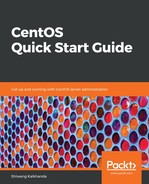Each SELinux violation is assigned a unique identifier (UUID). This UUID is used with the sealert command to produce a summary of a report for a specific incident.
For example, let's create a file in root's home directory and move this file into /var/www/html/. Now, try to access that file through the web browser or from the command line using curl as shown in the following diagram:

The error report of the SELinux violation can be viewed now, using the UUID and sealert command, as shown in the following screenshot:

On applying the suggestions of the SELinux violation given in the sealert report, it will remove the error and allow access to the file using the curl command as shown in the following screenshot:

